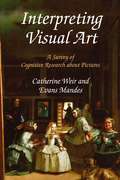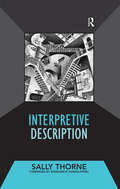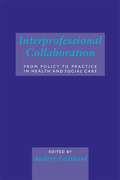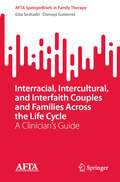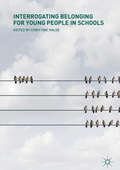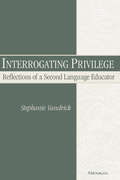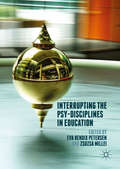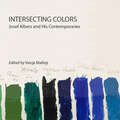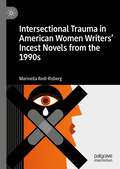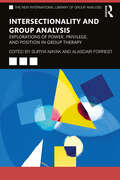- Table View
- List View
Interpreting Statistics for Beginners: A Guide for Behavioural and Social Scientists
by Vladimir Hedrih Andjelka HedrihInterpreting Statistics for Beginners teaches readers to correctly read and interpret results of basic statistical procedures as they are presented in scientific literature, and to understand what they can and cannot infer from such results. The first of its kind, this book explains key elements of scientific paradigms and philosophical concepts that the use of statistics is based on and introduces readers to basic statistical concepts, descriptive statistics and basic elements and procedures of inferential statistics. Explanations are accompanied with detailed examples from scientific publications to demonstrate how the procedures are used and correctly interpreted. Additionally, Interpreting Statistics for Beginners shows readers how to recognize pseudoscientific claims that use statistics or statements not based on the presented data, which is an important skill for every professional relying on statistics in their work. Written in an easy-to-read style and focusing on explaining concepts behind statistical calculations, the book is most helpful for readers with no previous training in statistics, and also those wishing to bridge the conceptual gap between doing the statistical calculations and interpreting the results.
Interpreting The Mmpi-3
by Martin Sellbom Yossef S. Ben-PorathAn essential guide to detailed and accurate interpretation of the MMPI-3 The MMPI-3 builds on the history and strengths of the MMPI instruments to provide an empirically validated, psychometrically up-to-date standard for psychological assessment. Updating and expanding the information found in MMPI-3 test manuals, Interpreting the MMPI-3 is an indispensable resource for practicing clinicians and a vital textbook for graduate psychological assessment courses that use and study this singular psychological instrument. Yossef S. Ben-Porath, coauthor of the MMPI-3, and Martin Sellbom, a leading expert on the MMPI instruments, provide detailed descriptions and interpretive recommendations for test scales, along with illustrative cases from a wide variety of settings, including forensic (criminal and civil), medical, and personnel screening. This core interpretive content places the MMPI-3 at the forefront of contemporary psychological assessment, while also providing important background on older versions of the test. This volume includes an in-depth look at the test’s history, development, administration, and interpretation, and it also addresses diversity-sensitive assessment with the test. A comprehensive guide for clinicians, researchers, and students, this book sets the standard for interpretation of and instruction on the MMPI-3. A book-based exam offering Continuing Education (CE) credit is available for this publication. Visit upress.umn.edu/test-division for more information.
Interpreting Visual Art: A Survey of Cognitive Research About Pictures
by Catherine Weir Evans MandesInterpreting Visual Art explores the psychological and cognitive mechanisms that underlie one's interpretation of art. After the brain encodes visual information, this encoding is then processed by perceptual mechanisms to identify objects and depth in pictures. The brain incorporates many factors in order for people to "see" the art. Cognitive processes have a major role in how people interpret artworks because attention, memory, and language are also linked to the aesthetic experience. Catherine Weir and Evans Mandes first examine major attributes of aesthetic judgement - balance, symmetry, color, line, and shape - from an empirical point of view as opposed to more philosophical and speculative approaches. Then, they explore the perceptual process, paying special attention to art history in the Western world and emphasizing techniques from cave paintings to modern art. The role beauty and emotions play in our interpretations of pictures have been investigated from many approaches: evolutionary psychology, neuroscience, and appraisal theory. Through the application of empirical research in cognitive science to master works from Botticelli to Pollock, readers are introduced to a research-oriented understanding of how art has been perceived, interpreted, and appreciated in the twenty-first century. This book will appeal to those interested in art as well as those teaching art history, psychology, and neuroscience.
Interpreting and Using Statistics in Psychological Research
by Andrew N. ChristopherThis practical, conceptual introduction to statistical analysis by award-winning teacher Andrew N. Christopher uses published research with inherently interesting social sciences content to help students make clear connections between statistics and real life. Using a friendly, easy-to-understand presentation, Christopher walks students through the hand calculations of key statistical tools and provides step-by-step instructions on how to run the appropriate analyses for each type of statistic in SPSS and how to interpret the output. With the premise that a conceptual grasp of statistical techniques is critical for students to truly understand why they are doing what they are doing, the author avoids overly formulaic jargon and instead focuses on when and how to use statistical techniques appropriately.
Interpreting and Using Statistics in Psychological Research
by Andrew N. ChristopherThis practical, conceptual introduction to statistical analysis by award-winning teacher Andrew N. Christopher uses published research with inherently interesting social sciences content to help students make clear connections between statistics and real life. Using a friendly, easy-to-understand presentation, Christopher walks students through the hand calculations of key statistical tools and provides step-by-step instructions on how to run the appropriate analyses for each type of statistic in SPSS and how to interpret the output. With the premise that a conceptual grasp of statistical techniques is critical for students to truly understand why they are doing what they are doing, the author avoids overly formulaic jargon and instead focuses on when and how to use statistical techniques appropriately.
Interpretive Description: Qualitative Research For Applied Practice (Developing Qualitative Inquiry Ser. #2)
by Sally ThorneThis book is designed to guide both new and more seasoned researchers through the steps of conceiving, designing, and implementing coherent research capable of generating new insights in clinical settings. Drawing from a variety of theoretical, methodological, and substantive strands, interpretive description provides a bridge between objective neutrality and abject theorizing, producing results that are academically credible, imaginative, and clinically practical. Replete with examples from a host of research settings in health care and other arenas, the volume will be an ideal text for applied research programs.
Interpretive Ethnography of Education at Home and Abroad
by George Louise SpindlerThis ambitious and unique volume sets a standard of excellence for research in educational ethnography. The interpretive studies brought together in this volume are outstanding discipline-based analyses of education both in the United States and in complex societies abroad.
Interpretive Voices: Responding to Patients
by Jean ArundaleThe contributions in this book exemplify ways in which different analysts think about and treat the issue of interpretation, illustrating the distinctiveness with which an analyst expresses his or her own personality, creativity, and understanding within the medium of psychoanalysis. Entering the realm of the philosophical concept of the particularised universal in which the general concept finds its expression not in abstraction but only in its particular manifestation, each analyst construes the theories and body of knowledge of psychoanalysis in his or her own way. The editors believe that the analytic process can embrace not only different theoretical views, but also differences in how we listen to and communicate with our patients, the expressions of which create an analytic climate with its own particular diction, vocabulary, and distinctive voice. The individual voice is implicit in the literature, capable of being demonstrated, and an important factor in the analytic process.
Interprofessional Care Coordination for Pediatric Autism Spectrum Disorder: Translating Research into Practice
by Jeffrey D. Shahidullah Maryellen Brunson McClain Katherine R. MezherThis book addresses the importance and relevance of interprofessional care coordination for children and youth with autism spectrum disorder (ASD). It covers the role of interprofessional collaborations across various settings for multiple service provision purposes. The volume examines interprofessional collaboration among professionals across such broad issues as screening, evaluation, intervention, and overall care management of ASD. In addition, the book explores more narrowly focused issues, such as providing transition services during early childhood and young adulthood, culturally responsive practice and advocacy issues for individuals with ASD from diverse backgrounds, and providing care for individuals with ASD and co-occurring trauma. Finally, the book concludes with the editors’ recommendations for future directions in interprofessional care for pediatric ASD. Topics featured in this book include:Autism screening tools and interdisciplinary coordination of the processes.Dell Children’s (S)TAAR Model of Early Autism Assessment.The Early Start Denver Model (ESDM).Transition from early schooling for youth with ASD.Postsecondary and vocational opportunities for youth with autism.Transitioning from pediatric to adult medical systems.International perspectives in coordinated care for individuals with ASD.Psychopharmacology of ASD. Interprofessional Care Coordination for Pediatric Autism Spectrum Disorder is an essential resource for researchers, clinicians and professionals, and graduate students in clinical child and school psychology, social work, behavioral therapy and related disciplines, including clinical medicine, clinical nursing, counseling, speech and language pathology, and special education.
Interprofessional Care and Mental Health: A Discursive Exploration of Team Meeting Practices (The Language of Mental Health)
by Cordet Smart Timothy AuburnThis book utilises conversation analysis (CA) and discursive psychology (DP) methodologies to examine the internal workings of multi-disciplinary teams which are concerned with the care, treatment and diagnosis of clients with complex mental health needs. Bringing together practitioners, service users and researchers who were part of the MDTsInAction research project, the authors offer a unique and systematic investigation into the ways members of multidisciplinary teams collaboratively manage their shared goals. A particular focus is on the language used in team meetings, and how examination of meeting talk can help us better understand the practice of inter-professional working. The authors also describe how a range of institutional barriers and concerns needed to be tackled in implementing the study in a healthcare setting. Over the course of this book they reveal a number of methodological developments which will be of interest to researchers and academics in CA/DP, and in healthcare communication generally. This book highlights how CA and DP can be used to identify and improve communicative practices in a healthcare setting; and also serves as an example of how to conduct an applied CA/DP project in a way that achieves impact.
Interprofessional Collaboration: From Policy to Practice in Health and Social Care
by Audrey LeathardInterprofessional collaboration in the health and social care services has become a commanding force, spear-headed by the Government's modernisation programme to improve partnership. Interprofessional Collaboration highlights the benefits and factors arising from working together for patients, service users and carers through a review of theoretical models illustrated by relevant examples. Discussion of topical problems being faced by practitioners, managers, and policy-makers in the health and social care sector covers:*Policy issues from various interprofessional angles, including the place of management, ethical issues and technology*The application of policy to practice in working together across professions, sectors and communities, giving an overview of teamwork, new primary care policies, interprofessional agendas for family support and mental health, and users' and carers' perspectives on collaboration in practice*Policy and practice in learning together, including theoretical challenges and developments internationally.Relevant for all those that have an interest in matters of health, social care, welfare and caring, Interprofessional Collaboration provides comprehensive coverage on interprofessional education and policy in the UK and abroad.
Interprofessional Simulation in Health Care: Materiality, Embodiment, Interaction (Professional and Practice-based Learning #26)
by Madeleine Abrandt Dahlgren Hans Rystedt Li Felländer-Tsai Sofia NyströmThis book describes and discusses a practice-oriented approach to understanding and researching interprofessional simulation-based education and simulation. It provides empirical findings from research on this topic and is informed by practice-oriented perspectives. It identifies critical features of the simulation practice and discusses how these can be used in reforming simulation pedagogy. The book is divided into three sections. Section 1 sets the scene for understanding the practices of interprofessional simulation-based education and simulation. It provides a theoretical and methodological framework for the conceptualisation of practices and for the empirical studies on which the book is based. Section 2 revisits the dimensions of the simulation process/exercise, i.e. the briefing, simulation, and debriefing, and provides empirical analyses of how the practice of simulation unfolds. Based on these analyses, section 3 identifies and discusses how pedagogies for simulation can be reformed to meet the demands of future healthcare and research.
Interracial Couples, Intimacy, and Therapy
by Kyle D. KillianGrounded in the personal narratives of twenty interracial couples with multiracial children, this volume uniquely explores interracial couples' encounters with racism and discrimination, partner difference, family identity, and counseling and therapy. It intimately portrays how race, class, and gender shape relationship dynamics and a partner's sense of belonging. Assessment tools and intervention techniques help professionals and scholars work effectively with multiracial families as they negotiate difference, resist familial and societal disapproval, and strive for increased intimacy. The book concludes with a discussion of interracial couples in cinema and literature, the sensationalization of multiracial relations in mass media, and how to further liberalize partner selection across racial borders.
Interracial Couples, Intimacy, and Therapy: Crossing Racial Borders
by Kyle KillianGrounded in the personal narratives of twenty interracial couples with multiracial children, this volume uniquely explores interracial couples' encounters with racism and discrimination, partner difference, family identity, and counseling and therapy. It intimately portrays how race, class, and gender shape relationship dynamics and a partner's sense of belonging. Assessment tools and intervention techniques help professionals and scholars work effectively with multiracial families as they negotiate difference, resist familial and societal disapproval, and strive for increased intimacy. The book concludes with a discussion of interracial couples in cinema and literature, the sensationalization of multiracial relations in mass media, and how to further liberalize partner selection across racial borders.
Interracial, Intercultural, and Interfaith Couples and Families Across the Life Cycle: A Clinician’s Guide (AFTA SpringerBriefs in Family Therapy)
by Gita Seshadri Dumayi GutierrezThis book examines issues of intersectionality and multicultural competency, humility, and sensitivity necessary to work with interracial, intercultural, and interfaith couples. It describes a therapeutic approach that combines a social constructionist framework with ecological systems theory using an intersectional lens. Chapters explore key issues relevant to interracial, intercultural, and interfaith couples across the lifespan, including attraction and dating, cohabitation, marriage and polyamory, children, retirement as well as such potentially challenging topics as sex, politics, and religion. Featured areas of coverage include: How to apply ecological systems theory and social constructionism to guide self of the therapist reflections and clinical interventions that address the nuances of intersectionality among interracial, intercultural, and interfaith couples across the lifespan. Attention to intersectionality between therapists and clients. Strategies for addressing challenging issues within the current political environment in which diversity is debated and may become divisive. Case applications and extended reflections Interracial, Intercultural, and Interfaith Couples and Families Across the Life Cycle: A Clinician’s Guide is an essential resource for clinicians, therapists, and practitioners as well as researchers, professors, and graduate students in family studies, clinical psychology, and public health, as well as all interrelated disciplines.
Interrogating Authenticity in Outdoor Education Teacher Education: Applications in Practice (Self-Study of Teaching and Teacher Education Practices #21)
by Chris J. NorthThis book addresses student passivity in teacher education. Using a developed metaphor, the author critically examines the use of authentic learning to design and implement learning experiences for preservice teachers, and reveals the opportunities and limitations of a focus on authenticity.This book prepares teachers for outdoor education using practice-based exemplars of applied teaching theories. Focusing on authentic pedagogies, it applies to all teacher educators who seek to engage in high-impact learning for their students, and is relevant for in-service educators, preservice teachers and researchers in the field of self-study.
Interrogating Belonging for Young People in Schools
by Christine HalseIn an era when many young people feel marginalized and excluded, this is the first comprehensive, critical account to shed new light on the trouble of ‘belonging’ and how young people in schools understand, enact and experience ‘belonging’ (and non-belonging). It traverses diverse dimensions of identity, including gender and sexuality; race, class, nation and citizenship; and place and space. Each section includes a provocative discussion by an eminent and international youth scholar of youth, and is essential reading for anyone involved with young people and schools. This book is a crucial resource and reference for sociology of education courses at all levels as well as courses in student inclusion, equity and student well-being.
Interrogating Privilege: Reflections of a Second Language Educator
by Stephanie VandrickInterrogating Privilege is a welcome combination of personal essays and academic research, blending theory, analysis, and narrative to explore the function and consequences of privilege in second language education. While teachers’ focus on the learning process and class goals are quite important, there is not enough attention paid to the types of privilege—or lack thereof—that individuals bring to the classroom. Through chapters that can either stand alone or be read together, with topics such as gender, age, and colonialism (the author is the daughter of missionary parents) in second language teaching, this book seeks to address the experiences of teachers, scholars, and students as “whole persons” and to observe the workings of identity and privilege in the educational setting.
Interrogating Psychiatric Narratives of Madness: Documented Lives
by Andrea Daley Merrick D. PillingThis book challenges the perception of the psychiatric chart as a neutral and objective text. The chapters included in this book coalesce to reveal the psychiatric chart as a text that is, in fact, “storied” by institutional ideology that reflects, reinforces, reinterprets, and, at times, resists gendered, raced, sexualized, and classed norms, values, and presuppositions. Intersectional analysis highlights the nuanced ways in which dominant ideologies are activated in chart documentation to produce qualitatively specific psychiatric narratives of distress and related responses in the psychiatric institution. The book serves as a much-needed resource for mental health professionals, education and training programs, and researchers that meaningfully takes into account the social and structural materiality of people’s lives and its impact on experiences of distress. It will also appeal to scholars investigating equity in health care across the fields of Critical Psychology, Disability Studies, Social Work, Allied Health, Mad Studies and Social Justice.
Interrupting Racism: Equity and Social Justice in School Counseling
by Rebecca Atkins Alicia OglesbyInterrupting Racism provides school counselors with a brief overview of racial equity in schools and practical ideas that a school-level practitioner can put into action. The book walks readers through the current state of achievement gap and racial equity in schools and looks at issues around intention, action, white privilege, and implicit bias. Later chapters include interrupting racism case studies and stories from school counselors about incorporating stakeholders into the work of racial equity. Activities, lessons, and action plans promote self-reflection, staff-reflection, and student-reflection and encourage school counselors to drive systemic change for students through advocacy, collaboration, and leadership.
Interrupting the Psy-Disciplines in Education
by Zsuzsa Millei Eva Bendix PetersenThis book offers critical explorations of how the psy-disciplines, Michel Foucault's collective term for psychiatry, psychology and psycho-analysis, play out in contemporary educational spaces. With a strong focus on Foucault's theories, it critically investigates how the psy-disciplines continue to influence education, both regulating and shaping behaviour and morality. The book provides insight into different educational contexts and concerns across a child's educational lifespan; early childhood education, inclusive education, special education, educational leadership, social media, university, and beyond to enable reflection and critique of the implications of psy-based knowledge and practice. With chapters by a mixture of established and emerging international scholars in the field this is an interdisciplinary and authoritative study into the role of the psy-disciplines in the education system. Providing vivid illustrations from throughout the educational lifespan the book serves as an invaluable tool for reflection and critique of the implications of psy-based practice, and will be of particular interest to academics and scholars in the field of education policy and psychology.
Interruptions in Identity: Engaging with Suicidality among the Indian Youth
by Ambika SinghInterruptions in Identity: Engaging with Suicidality among the Indian Youth explores the shift in the author’s perspective from an understanding of ‘suicide’ to an exploration of suicidality. The shift came organically from her experience of working in a university clinic and interacting with individuals who had communicated to her the presence of ‘suicidal thoughts’ during their sessions. The work is also an examination of how studying a tendency towards committing suicide is necessarily an attempt to understand the complex interplay of the personal and the social which often leads to that tendency described as suicidality. The work turns a psychosocial lens and further elaborates on how suicidality expresses itself in the space between the subject and the therapist within the safe space of a clinic. In taking us through these narratives, the author builds a case that it is important to reflect not just on the nature of individual suffering but also its interaction with the prevalent and relevant socio-political forces
Intersecting Colors: Josef Albers and His Contemporaries
by Vanja MalloyJosef Albers (1888–1976) was an artist, teacher, and seminal thinker on the perception of color. A member of the Bauhaus who fled to the U.S. in 1933, his ideas about how the mind understands color influenced generations of students, inspired countless artists, and anticipated the findings of neuroscience in the latter half of the twentieth century. With contributions from the disciplines of art history, the intellectual and cultural significance of Gestalt psychology, and neuroscience, Intersecting Colors offers a timely reappraisal of the immense impact of Albers’s thinking, writing, teaching, and art on generations of students. It shows the formative influence on his work of non-scientific approaches to color (notably the work of Johann Wolfgang von Goethe) and the emergence of Gestalt psychology in the first decades of the twentieth century. The work also shows how much of Albers’s approach to color—dismissed in its day by a scientific approach to the study and taxonomy of color driven chiefly by industrial and commercial interests—ultimately anticipated what neuroscience now reveals about how we perceive this most fundamental element of our visual experience. Edited by Vanja Malloy, with contributions from Brenda Danilowitz, Sarah Lowengard, Karen Koehler, Jeffrey Saletnik, and Susan R. Barry.
Intersectional Trauma in American Women Writers' Incest Novels from the 1990s
by Marinella Rodi-RisbergThis book explores the intersections of sexualized, gendered, and racialized traumas in five US novels about father-daughter incest from the 1990s. It examines how incest can be connected to wider past and present structural oppression and institutional abuse, and what fiction looks like that testifies against and references a historical background of slavery, poverty, settler colonialism, annexation, and immigration. Investigating the means of resistance used against attempts at silencing and denial in these texts, the book also shows how contemporary women’s novels can propose social change. Overall, this study uniquely argues that the individual trauma of incest in these texts must be understood in relation to histories of and present collective wounding against marginalized communities. By sitting at the intersections between trauma theory and US third world feminism, it allows for theory to meet literary activism.
Intersectionality and Group Analysis: Explorations of Power, Privilege, and Position in Group Therapy (ISSN)
by Suryia Nayak Alasdair ForrestDrawing on clinical practice, this book explores how the Black feminist idea of intersectionality is vital to all group work practices, including group analysis.Intersectionality enables exploration of power, position, and privilege in group work; this volume is an argument for the ‘decolonizing’ of therapeutic group training, practice, and institutional traditions. The wide range of contributors discuss the impact of intersectionality on their work within group analysis, from clinical examples to theoretical reflections. Chapters span topics such as leadership, racism, working with survivors of sexual violence, and the experience of being a political refugee. Intersectionality and Group Analysis provides a space to develop clinically relevant theory for the future and includes an accessible introduction to the concepts of intersectionality.This essential text will be key reading for group analysts, other professionals working with and within groups, and readers looking to learn more about enhancing diversity within structures and organizations.


